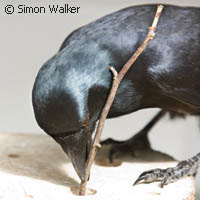Study highlights impact of tool use on crows' diet
Highly-nutritious grubs that can only be accessed with the help of tools make a significant contribution to crows' diet, new research reveals. Crows' tool-wielding habits have been known about for some time; the new study, published in the journal Science, sheds light on the selection pressures driving tool use in these fascinating birds. Crows and related birds, such as ravens and jays, are widely recognised as being among the smartest birds around. New Caledonian crows (Corvus moneduloides), which live on the remote tropical island of New Caledonia in the south Pacific, are particularly innovative, manufacturing and using a broad array of tools in their daily lives. Studies on captive birds have also uncovered exceptional problem-solving skills. This study focused on wild birds' habit of 'fishing' for the larvae of longhorn beetles in the decaying trunks of candlenut trees. The plump little bugs live in burrows in the wood, out of the reach of the inquisitive birds' beaks. To access the tasty morsels, the crow inserts a twig or leaf stem into the burrow and 'teases' the larva by gently prodding it. This arouses the larva's defensive responses and eventually it clamps its powerful jaws onto the tip of the tool; once the crow has snared its prey, it levers the unfortunate grub out of its burrow. Chimpanzees employ a similar trick when fishing for termites. Studies have shown that fishing for larvae in this way requires great skill; although young crows quickly start experimenting with tool use, and may even learn some tricks from their parents, their grub-fishing attempts are rarely successful until at least their first or even second year after fledging. Furthermore, even for older birds that are adept at tool use, fishing for larvae is a time-consuming process. So why do they persevere? This study reveals that longhorn beetle grubs are extremely rich in fat and they contribute significantly to birds' energy intake. In fact, just a few larvae are enough to meet a crow's daily energy requirements. 'Our results show that tool use provides New Caledonian crows with access to an extremely profitable food source that is not easily exploited by beak alone,' commented Dr Christian Rutz of Oxford University in the UK. 'This suggests that unusual foraging opportunities on the remote, tropical island of New Caledonia selected for, and currently maintain, these crows' sophisticated tool technology. Other factors have probably played a role too, but at least we now have a much better understanding of the dietary significance of this remarkable behaviour.' The second most important component of the crows' diet is the candlenut itself; the birds break these by dropping them onto hard surfaces. In fact that candlenut tree was probably brought to the island by humans. 'In light of our findings, it seems possible that the anthropogenic introduction of this tree species to new Caledonia created foraging opportunities (i.e. lipid-rich, but hidden, larvae) that, presumably in combination with other factors, led to the rapid evolution of tool use in [New Caledonian] crows,' the researchers speculate. Wild New Caledonian crows live in dense forest so observing what they eat directly is nigh on impossible. Instead, the scientists took a different approach, applying a novel approach to the old adage 'you are what you eat'. Different foods have a different 'chemical fingerprint'. Longhorn beetle larvae have an unusual diet and so display a particularly distinct fingerprint which shows up in the tissues of anything that eats them. The team trapped wild birds and analysed blood and feather samples, looking for the signatures of the birds' main foods. 'By comparing the stable isotope profiles of the crow's tissues with those of their putative food sources, we could estimate the proportion of larvae in crow diet, providing a powerful proxy for individual tool-use dependence,' said Dr Rutz. Looking to the future, the team are keen to find out if the most skilled tool users, which obtain more larvae, also produce fitter offspring and whether a diet rich in larvae has long-term effects on individual birds' ability to reproduce and survive. Dr Rutz concludes: 'The fact that we can estimate the importance of tool use from a small tissue sample opens up exciting possibilities. This approach may even be suitable for studying other animal tool users, like chimpanzees.'
Countries
New Caledonia, United Kingdom



